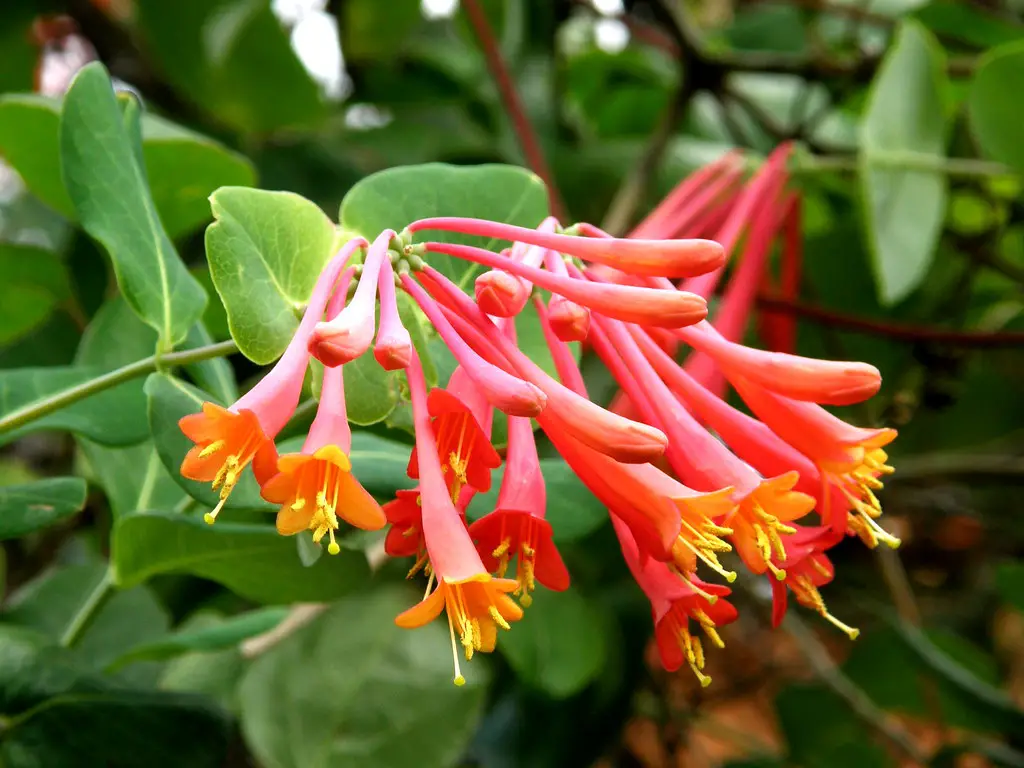Coral Honeysuckle, known scientifically as Lonicera sempervirens, is a captivating climbing vine cherished for its abundant clusters of trumpet-shaped flowers. Native to the southeastern United States, it has become an alluring feature in many gardens and landscapes. The vivid coral or red blossoms, accompanied by contrasting yellow interiors, add a splash of color and can bloom from spring through fall.
Adored not only for its visual appeal, Coral Honeysuckle is a valuable addition to any garden that aims to attract pollinators. Hummingbirds, in particular, are drawn to the tubular flowers, providing endless opportunities to witness their delicate beauty. In addition to its attractive flowers, Coral Honeysuckle also produces red to orange berries, adding to its seasonal interest.
Unlike some other honeysuckle species, Coral Honeysuckle is non-invasive and well-behaved, making it a favorite among gardeners. Its ability to climb and sprawl makes it ideal for covering fences, trellises, and arbors. Its vibrant growth and relatively low maintenance requirements contribute to its popularity among both novice and experienced gardeners.
| Attribute | Details |
|---|---|
| Common Names | Coral Honeysuckle, Trumpet Honeysuckle |
| Botanical Name | Lonicera sempervirens |
| Family | Caprifoliaceae |
| Plant Type | Climbing vine |
| Mature Size | 10-15 feet |
| Sun Exposure | Full sun to partial shade |
| Soil Type | Well-drained, sandy, loam |
| Hardiness Zones | 4-9 |
| Native Area | Southeastern United States |
Coral Honeysuckle Care
Caring for Coral Honeysuckle is quite straightforward, making it suitable for a wide range of gardeners. The plant thrives in well-drained soil and requires regular watering, particularly during the first growing season. Once established, it becomes more drought-tolerant.
Providing support for the vine to climb will showcase its full potential, and a sunny spot will encourage more prolific blooming. While Coral Honeysuckle can tolerate some shade, too much may result in fewer flowers and a leggier growth habit.
Light Requirement for Coral Honeysuckle
Coral Honeysuckle prefers full sun to partial shade. While it can tolerate some shade, planting it in a spot that receives at least six hours of sunlight daily will promote more abundant flowering and healthier growth.
Soil Requirements for Coral Honeysuckle
Coral Honeysuckle is quite adaptable and can grow in various soil types. Well-drained, sandy, or loamy soil with a slightly acidic to neutral pH is optimal. Adding organic matter to the planting hole will enhance growth, especially in poorer soil.
Water Requirements for Coral Honeysuckle
Regular watering during the initial growing season helps Coral Honeysuckle to establish a robust root system. Thereafter, it is relatively drought-tolerant but benefits from consistent watering during dry spells.
Temperature and Humidity
Coral Honeysuckle can adapt to a wide range of temperature conditions, thriving in USDA hardiness zones 4-9. Humidity typically does not pose a problem for this plant, but proper spacing and pruning can help ensure adequate airflow and prevent potential fungal issues.
Fertilizer
Coral Honeysuckle does not require heavy fertilization. Applying a balanced, slow-release fertilizer in early spring can boost growth, particularly in less fertile soils.
Pruning Coral Honeysuckle
Pruning can be performed to shape the vine and remove dead or diseased growth. An annual pruning in late winter or early spring is usually sufficient to keep the plant looking vibrant and healthy.
Propagating Coral Honeysuckle
Propagating Coral Honeysuckle can be done through cuttings or division. Cuttings can be taken in the spring, treated with rooting hormone, and planted in a well-draining medium.
How To Grow Coral Honeysuckle From Seed
Growing Coral Honeysuckle from seed requires patience. Seeds should be cold stratified for about two months before sowing. Plant the seeds in well-draining soil and keep them moist until germination.
Common Pests & Plant Diseases
Aphids
Aphids can be managed with insecticidal soap or neem oil.
Powdery Mildew
Proper spacing and pruning can prevent powdery mildew.
Leaf Spot
Leaf spot can be treated with fungicides and by removing affected leaves.
Common Problems With Coral Honeysuckle
Leggy Growth
Insufficient sunlight can lead to leggy growth. Ensure the plant receives enough light.
Failure to Flower
Lack of flowering may be due to too much shade or poor soil conditions. Adjust location or soil nutrients as needed.
Pro Tips
- Plant Coral Honeysuckle near seating areas to enjoy the visiting hummingbirds.
- Pair with other native plants for a harmonious and wildlife-friendly garden.
- Use Coral Honeysuckle to cover unattractive fences or structures.
- Monitor regularly for signs of pests and diseases to address problems early.
- Consider mixing Coral Honeysuckle with other climbing plants for a unique visual display.




